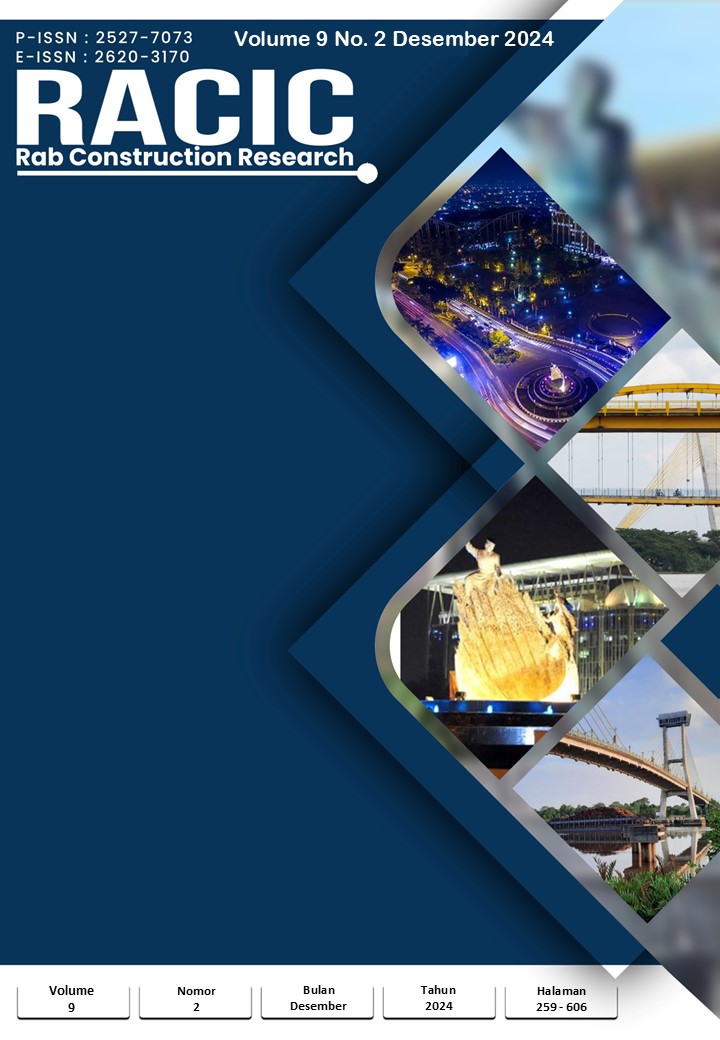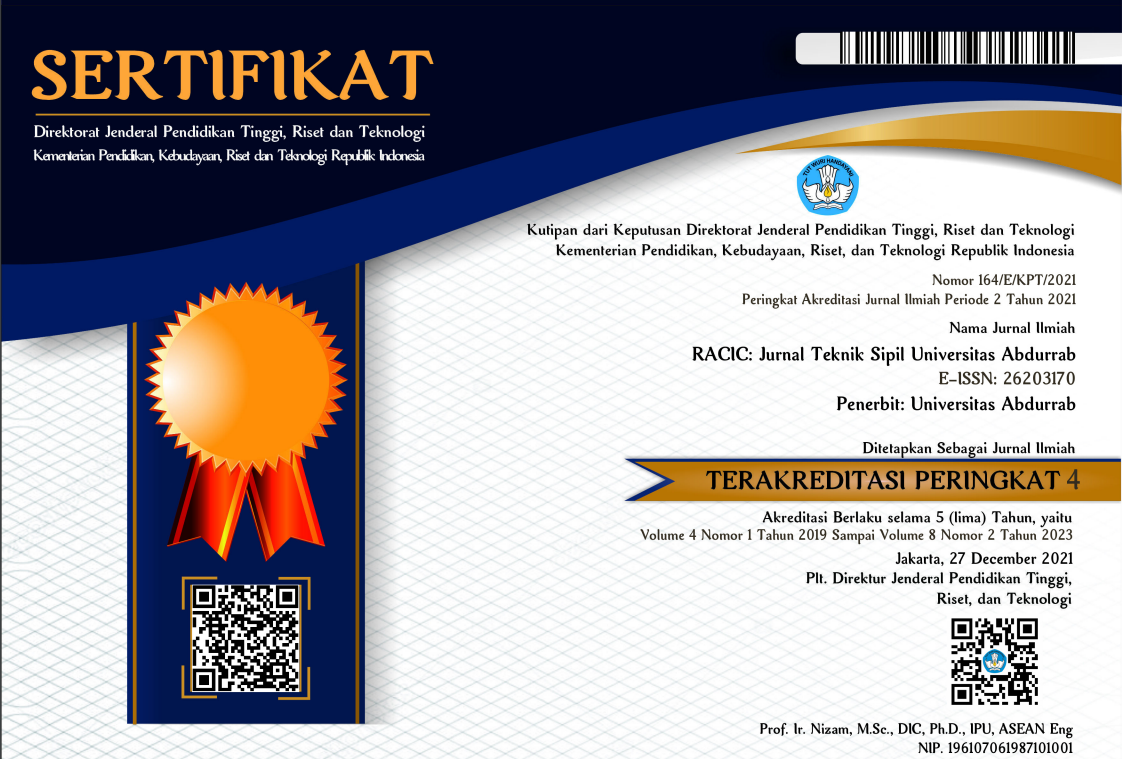COMPARISON STUDY OF BIM MODELING IN SEISMIC ANALYSIS FOR DIFFERENT BUILDING FUNCTIONS BASED ON SNI 1726:2019
english
DOI:
https://doi.org/10.36341/racic.v9i2.4861Keywords:
Structure, Building Information Modeling, Story Shear, Story DisplacementAbstract
The application of BIM in Indonesia in building planning which refers to SNI 1726:2019 is still very minimal. This research involves two different types of buildings, namely hotel buildings and hospitals. The modeling used is simple concrete building structure modeling with variations of 3, 9 and 12 floors in Revit as a model. The same BIM model is used in the Structural Analysis Robot and then the results of the two buildings are compared, namely the comparison of story shear and story displacement. The research methods used are data collection, BIM modeling using the latest software, and seismic analysis taking into account the parameters described in SNI 1726:2019. The results of BIM modeling and seismic analysis were then compared for both types of buildings.
Downloads
References
H. M. F. Shehzad, A. Fadhil, R. B. Ibrahim, K. Khaidzir, CII, The role of interoperability dimensions in building information modelling, 129, (2021)
Badan Pusat Statistik, Kosntruksi dalam Angka 2023, BPS RI, 2023
R. Sulistian, J. Sjah, A.D. Rasarati, J.J. Oetomo, Sci. and Eng. Investigations, A Study of BIM Modelling in Seismic Analysis according to SNI 1726:2019, 11, (2022)
Sampaio, A.Z., Gomes, A.M. and Farinha, T. (2021) BIM Methodology Applied in Structural Design: Analysis of Interoperability in ArchiCAD/ ETABS Process. Journal of Software Engineering and Applications, 14, 189-206. https://doi.org/10.4236/jsea.2021.146012
Ciotta, V.; Asprone, D.; Manfredi, G.; Cosenza, E. Building Information Modelling in Structural Engineering: A Qualitative Literature Review. CivilEng 2021, 2, 765–793. https://doi.org/10.3390/ civileng2030042
Whitlock, K.; Abanda, F.H.; Manjia, M.B.; Pettang, C.; Nkeng, G.E. 4D BIM for Construction Logistics Management. CivilEng 2021, 2, 325–348. https://doi.org/10.3390/ civileng2020018
Sampaio, A.Z.; Gomes, A.M. BIM Interoperability Analyses in Structure Design. CivilEng 2021, 2, 174–192. https://doi.org/10.3390/ civileng2010010
Musella, C.; Serra, M.; Salzano, A.; Menna, C; Asprone, D. Open BIM Standards: A Review of the Processes for Managing Existing Structures in the Pre- and Post-Earthquake Phases. CivilEng 2020, 1(3), 291-309; https://doi.org/10.3390/civileng1030019
Khatiwada, P.; Hu, Y.; Lumantarna, E.; Menegon, S.J. Dynamic Modal Analyses of Building Structures Employing Site-Specific Response Spectra Versus Code Response Spectrum Models. CivilEng 2023, 4, 134–150. https://doi.org/ 10.3390/civileng4010009
Algamati, M.; Al-Sakkaf, A.; Mohammed Abdelkader, E.; Bagchi, A. Studying and Analyzing the Seismic Performance of Concrete Moment-Resisting Frame Buildings. CivilEng 2023, 4, 34–54. https:// doi.org/10.3390/civileng4010003
Hu, Y.; Lam, N.; Khatiwada, P.; Menegon, S.J.; Looi, D.T.W. Site-Specific Response Spectra: Guidelines for Engineering Practice. CivilEng 2021, 2, 712–735. https://doi.org/10.3390/ civileng2030039
Mamaghani, M.; Lui, E.M. Use of Continuous Wavelet Transform to Generate Endurance Time Excitation Functions for Nonlinear Seismic Analysis of Structures. CivilEng 2023, 4, 753–781. https://doi.org/10.3390/ civileng4030043
Samsami, R. A Systematic Review of Automated Construction Inspection and Progress Monitoring (ACIPM): Applications, Challenges, and Future Directions. CivilEng 2024, 5, 265–287. https://doi.org/ 10.3390/civileng5010014
Apriansyah, R. Implementation of Building Information Modeling (BIM) Concepts in Estimating Quantity Take Off of Structural Work Materials. Faculty of Civil Engineering and Planning, Islamic University of Indonesia, 2021.
Stefano Cursi, Letizia Martinelli, Nicolo ` Paraciani, Filippo Calcerano, Elena Gigliarelli, Linking external knowledge to heritage BIM. ISPC Institute of Heritage Science, National Research Council, Montelibretti (RM), Italy. 2022
Yije Kim, Sangyoon Chin, Seungyeon Choo, BIM data requirements for 2D deliverables in construction documentation. Department of Convergence Engineering for Future City, Sungkyunkwan University, Suwon 16419, Republic of Korea, 2022
Jiao Chen, Yongquan Luo, Hongfei Zhang, Weibing Du (2021), Quality evaluation of lightweight realistic 3D model based on BIM forward design. Shanghai Municipal Engineering Design Institute (Group) Co., Ltd, Shanghai, China
Yunfan Zhao, Xueyuan Deng, Huahui Lai (2021). Reconstructing BIM from 2D structural drawings for existing buildings. Shanghai Jiao Tong University, China.
Seung-Il Lee, Jun-Seo Bae, Young Sang Cho (2021). Efficiency analysis of Set-based Design with structural building information modeling (S-BIM) on high-rise building structures. Hanyang University, Republic of Korea
Abdullahi B. Saka *, Daniel W.M. Chan, Ibrahim Y. Wuni, Knowledge-based decision support for BIM adoption by small and medium-sized enterprises in developing 30 economies. Department of Building and Real Estate, The Hong Kong Polytechnic University, Hung Hom, Kowloon, Hong Kong. 2022
S. Tang, X. Li, Xiaoming Zheng, Bo Wu, Weixi Wang, Yunjie Zhang, BIM generation from 3D point clouds by combining 3D deep learning and improved morphological approach. d Department of Architecture and Civil Engineering, City University of Hong Kong, Hong Kong, PR China. 2022
Ying Hong, Ahmed W.A. Hammad, Ali Akbar Nezhad, Optimising the implementation of BIM: A 2-stage stochastic programming approach. School of Engineering and Built Environment, Griffith University, Queensland, Australia. 2022
Badan Standardisasi Nasional, SNI 1726:2019: Tata Cara Perencanaan Ketahanan Gempa untuk Struktur Bangunan Gedung dan Nongedung, Jakarta: Badan Standardisasi Nasional, 2019.
Standar Nasional Indonesia, SNI 1727:2020 Beban desain minimum dan kriteria terkait. Jakarta: Badan Standar Nasional, 2020.
Standar Nasional Indonesia (2019). SNI 2847:2019 Persyaratan beton structural untuk bangunan Gedung dan penjelasan. Jakarta: Badan Standar Nasional
Downloads
Published
Issue
Section
License
1. Copyright of all journal manuscripts is held by the RACIC : Rab Construction Research
2. Formal legal provisions to access digital articles of electronic journal are subject to the provision of the Creative Commons Attribution-ShareAlike license (CC BY-NC-SA), which means that RACIC : Rab Construction Research is rightful to keep, transfer media/format, manage in the form of databases, maintain, and publish articles.
3. Published manuscripts both printed and electronic are open access for educational, research, and library purposes. Additionally, the editorial board is not responsible for any violations of copyright law.
licensed under a Creative Commons Attribution-ShareAlike 4.0 International License.






